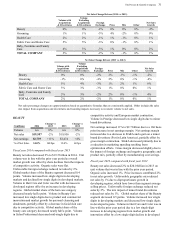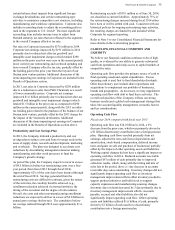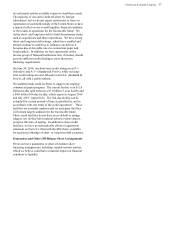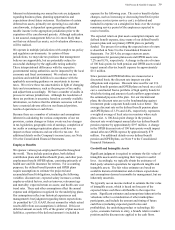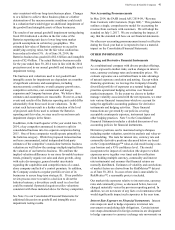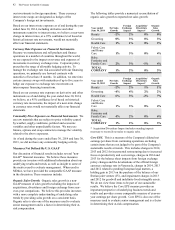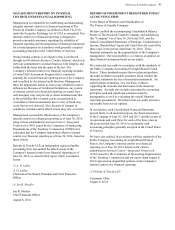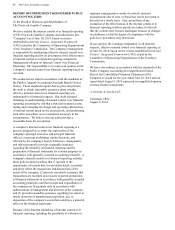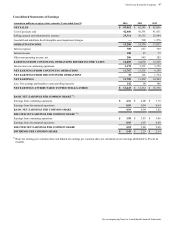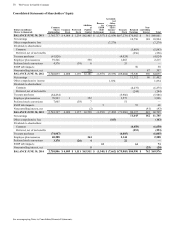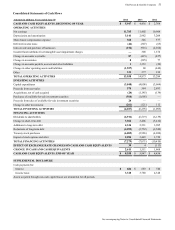Proctor and Gamble 2014 Annual Report Download - page 43
Download and view the complete annual report
Please find page 43 of the 2014 Proctor and Gamble annual report below. You can navigate through the pages in the report by either clicking on the pages listed below, or by using the keyword search tool below to find specific information within the annual report.The Procter & Gamble Company 41
rates consistent with our long-term business plans. Changes
to or a failure to achieve these business plans or a further
deterioration of the macroeconomic conditions could result
in a valuation that would trigger an additional impairment of
the goodwill and intangible assets of these businesses.
The results of our annual goodwill impairment testing during
fiscal 2014 indicated a decline in the fair value of the
Batteries reporting unit due to lower long-term market
growth assumptions in certain key geographies. The
estimated fair value of Batteries continues to exceed its
underlying carrying value, but the fair value cushion has
been reduced to about 5%. As of June 30, 2014, the
Batteries business has goodwill of $2.6 billion and intangible
assets of $2.4 billion. The actual Batteries business results
for the year ended June 30, 2014 were in line with the 2014
projections used in our annual goodwill and intangible asset
impairment testing.
The business unit valuations used to test goodwill and
intangible assets for impairment are dependent on a number
of significant estimates and assumptions, including
macroeconomic conditions, overall category growth rates,
competitive activities, cost containment and margin
expansion and Company business plans. We believe these
estimates and assumptions are reasonable. However, actual
events and results of the Batteries reporting unit could differ
substantially from those used in our valuations. To the
extent such factors result in a further reduction of the level
of projected cash flows used to estimate the Batteries
reporting unit fair value, we may need to record non-cash
impairment charges in the future.
In addition, in the fourth quarter of the year ended June 30,
2014, a key competitor announced its intent to split its
consolidated business into two separate companies during
2015. One of those companies would operate primarily in
the batteries category. While this proposed transaction has
not been consummated, initial independent third party
estimates of the competitor’s stand-alone batteries business
valuation are well below the earnings multiple implied from
the valuation of our batteries business. We attribute the
implied valuation differences to our more favorable business
trends, primarily organic net sales and share growth, along
with scale dis-synergies, general market uncertainty
regarding the capabilities and competitiveness of a stand-
alone company and lack of a control premium. In addition,
the Company conducts a regular portfolio review of its
businesses to assess long-term strategic fit. If our portfolio
review process were to result in a decision to divest the
batteries business, a divestiture could result in a loss that
could be material if potential acquirers utilize valuations
consistent with those indicated above for the key competitor.
See Note 2 to our Consolidated Financial Statements for
additional discussion on goodwill and intangible asset
impairment testing results.
New Accounting Pronouncements
In May 2014, the FASB issued ASU 2014-09, “Revenue
from Contracts with Customers (Topic 606).” This guidance
outlines a single, comprehensive model for accounting for
revenue from contracts with customers. We will adopt the
standard on July 1, 2017. We are evaluating the impact, if
any, that the standard will have on our financial statements.
No other new accounting pronouncement issued or effective
during the fiscal year had or is expected to have a material
impact on the Consolidated Financial Statements.
OTHER INFORMATION
Hedging and Derivative Financial Instruments
As a multinational company with diverse product offerings,
we are exposed to market risks, such as changes in interest
rates, currency exchange rates and commodity prices. We
evaluate exposures on a centralized basis to take advantage
of natural exposure correlation and netting. Except within
financing operations, we leverage the Company's broadly
diversified portfolio of exposures as a natural hedge and
prioritize operational hedging activities over financial
market instruments. To the extent we choose to further
manage volatility associated with the net exposures, we enter
into various financial transactions which we account for
using the applicable accounting guidance for derivative
instruments and hedging activities. These financial
transactions are governed by our policies covering
acceptable counterparty exposure, instrument types and
other hedging practices. Note 5 to the Consolidated
Financial Statements includes a detailed discussion of our
accounting policies for financial instruments.
Derivative positions can be monitored using techniques
including market valuation, sensitivity analysis and value-at-
risk modeling. The tests for interest rate, currency rate and
commodity derivative positions discussed below are based
on the CorporateManager™ value-at-risk model using a one-
year horizon and a 95% confidence level. The model
incorporates the impact of correlation (the degree to which
exposures move together over time) and diversification
(from holding multiple currency, commodity and interest
rate instruments) and assumes that financial returns are
normally distributed. Estimates of volatility and correlations
of market factors are drawn from the RiskMetrics™ dataset
as of June 30, 2014. In cases where data is unavailable in
RiskMetrics™, a reasonable proxy is included.
Our market risk exposures relative to interest rates, currency
rates and commodity prices, as discussed below, have not
changed materially versus the previous reporting period. In
addition, we are not aware of any facts or circumstances that
would significantly impact such exposures in the near term.
Interest Rate Exposure on Financial Instruments. Interest
rate swaps are used to hedge exposures to interest rate
movement on underlying debt obligations. Certain interest
rate swaps denominated in foreign currencies are designated
to hedge exposures to currency exchange rate movements on


